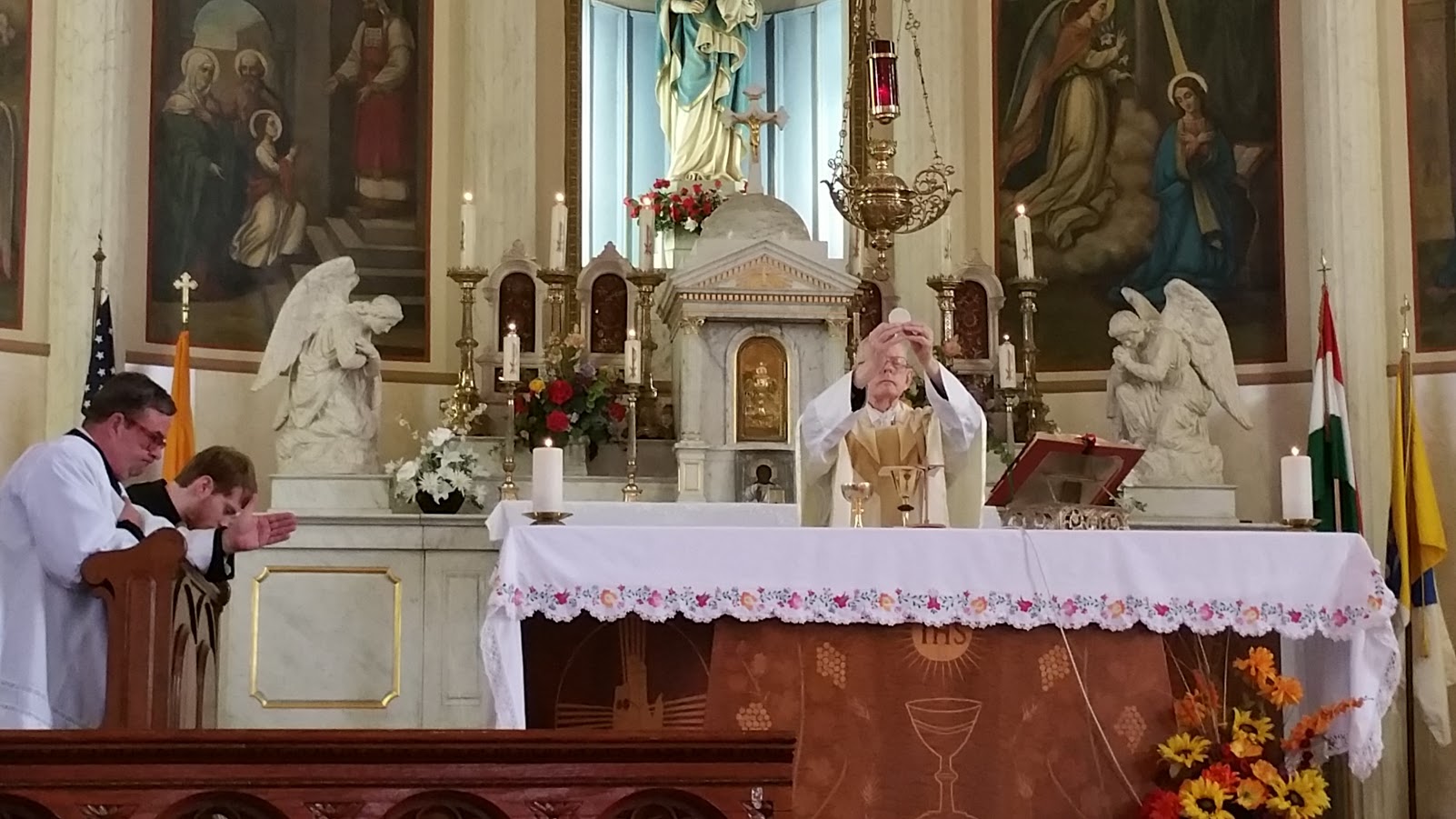12 June 2016, Sacred Heart (EF Missa Cantata)
Introit, Cogitationes,
Gradual: Dulcis et rectus,
Alleluia: Tollite jugum,
Offertory, Improperium ,
Communion, Unus militum,
Recessional, Ave verum, PBC, p. 92,
Ordinary from Mass IV (Cunctipotens genitor Deus), Ambrosian Gloria, Credo II. Solemn Ite.
In the seventeenth century, St. Margaret Mary Alacoque, a Visitation nun, received visions of Our Lord showing His Sacred Heart. She and others began pressing to have this feast on the universal calendar, but only in 1856 did Pius IX agree to these requests. Pius XI gave it an octave and raised it to the same rank as the feasts of Christmas and Ascension. It was assigned a new Mass formula and Office by his decree of January 29, 1929. The present Mass formula has various points in common with the Mass Miserebitur previously prescribed for the universal Church and the Mass Egredimini permitted to some localities. The thought which pervades today's feast is indicated by the Preface. In that beautiful composition, the pierced Heart of our Lord is glorified as the sanctuary of divine liberality, from which flow streams (torrentes) of mercy and grace. The Introit antiphon has two phrases:
[if !supportLists]1. [endif]Cogitationes cordis eius in generatione et generationem
[if !supportLists]2. [endif]ut eruat a morte animas eorum et alat eos in fame
The words point to the significance of the Sacred Heart of Jesus both to the world and to us individually. That it might deliver humanity from eternal death, the Heart of Jesus itself went into death. In order to appease the hunger of souls and bring salvation to the world, this Heart offered its very flesh and blood, together with its overflowing truth and love. And this offering was not an isolated event of the remote past, but continues from generation to generation—in generatione et generationem. There always have been and always will be souls that requite love for love by making a complete oblation of self. But there are also the great number of those who close their souls to the divine love, who are irresponsive to the many gifts of grace, and who show themselves faithless even to the point of hatred. In spite of all this, the Heart of Jesus has not become embittered; although wounded, it continues to pour forth the riches of its merciful love. It is ever faithful, prepared to give help in generatione et generationem. As the Mother of God sings of the mercies of the Lord that continue from generation to generation in her Magnificat, so the Preface of today reminds us that the fire of love in the Sacred Heart continues to burn without interruption. Hence, the words et generationem are not sung too hastily. Just as this love embraces all creation, we wish all creation to rejoice and sing the praises of the Sacred Heart. The fact that numberless holy souls in heaven and on earth join in our song of jubilation is a matter of encouragement and comfort.
Like the text, which is composed of different verses of the same psalm, the melody is a combination of various parts of several Introits. The melody over Cogitationes Cordis eius in generatio-(ne) shows some similarity to that over Domine refugium factus es nobis a generatio-(ne) at the beginning of the Introit for Tuesday of the first week of Lent. The fact that both excerpts end with the same word may well have brought about this association. The following et generationem repeats in abbreviated form the melody over conventum facite in the Introit Laetare of the fourth Sunday of Lent. The entire second phrase et eruat is the same as the third phrase of the Introit Laetare. In the original melody, exsultetis depicts a feeling of jubilation, the accented syllable of satiemini is effectively emphasized, while the wide intervals of a fourth and fifth, together with the agreeable melody which stresses the word accent of consolationis, give us a premonition and experience of the fullness of divine consolation. On account of its abbreviated text, today's new Introit had to contract the original melody.
The Gradual has four phrases, two in the corpus and two in the verse:
[if !supportLists]1. [endif]Dulcis et rectus Dominus,
[if !supportLists]2. [endif]propter hoc legem dabit delinquentibus in via.
[if !supportLists]3. [endif]V. Diriget mansuetos in judicio
[if !supportLists]4. [endif]docebit mites vias suas.
The text speaks to us of God's love. God is good to His creatures and faithful, despite our repeated failings to reciprocate that loving kindness. Despite our Lord's lament in the Reproaches of Good Friday, 'You have become to Me exceeding bitter,' He remains dulcis. Despite His lament 'All have turned from righteous ways,' He remains faithful. Out of the fullness of His love He gives us the Law, imparts to us enlightenment and grace, affords us the means whereby we can be absolved from the guilt of sin that we might again realize peace in our souls, and gives us the strength to order our life in accord with His divine will, which in turn will lead us to love others. His words will teach us how to become meek and humble, and will instill into us a desire to share with others His peace and contentment.
The melody over et rectus Dominus might be derived from the Gradual Concupivit rex of the Mass Vultum tuum (the second for a Virgin not a Martyr). The florid neums over et are found over the significant rex in the latter Mass. It is more probable, however, that today's melody is to be sought in the Gradual of the twenty-second Sunday after Pentecost (q.v.). At any rate, the beginning over Dulcis (ecce) and the entire melody from delinquentibus to the end is taken from that Gradual.
A note of importance seems to permeate the entire melody. Dulcis is sung somewhat slowly and subdued. The thoughts suggested at the beginning of the text are well accommodated to the range of a fifth over Dominus. The neums over mansuetos are also employed over (inquirent)-tes on All Saints. The coda of judicio is identified as a wandering melisma. The rich vocalization over suas occurs frequently as a termination of Graduals in the first mode.
The Alleluia Verse has two phrases
[if !supportLists]1. [endif]Tollite jugum meum super vos
[if !supportLists]2. [endif]et discite a me, quia mitis sum et humilis corde: et invenietis requiem animabus vestris
Our divine Saviour earnestly desires burdened souls to find their rest in Him. If we bear our yoke submissively, lose our own will in His divine will, and subject our desires to His divine dispensation—in other words, accept our state of life with its concomitant hardships as something which is ultimately to our advantage as the yoke appointed for us to bear—then we shall find rest for our souls.
The Gradual melody is the only one of today's Mass which is not modeled on some other melody. The sincerity and warmth which characterize its first part make it immediately appealing. Alleluia with its jubilus has the form a + b + c (c). The pressus on aa, gg and ee enliven the movement. Tollite jugum me-(um) is similar to -leluia with its jubilus. The motif over Tollite recurs in a slightly modified form over ju-(gum) and quia. The melody over (me)-um super vos and (qui)-a mitis sum shows an effective rhyme which, with its tender melody reminiscent of the Improperia of Good Friday, fits the text well. Although the melody at the conclusion is effective harmoniously, it all but isolates the humilis corde which follows and with which it is logically connected.
In view of this, the pause after mitis sum should be made very short. The richly developed melody over et and its inception of a sixth after the first pause recurs, with the exception of the first three notes, over re-(quiem). The same might be referred to that over mors in the Alleluia of the fourth Sunday after Easter. The melodic distinction given the word requiem is well merited. Its somewhat austere character indicates that this rest can be attained only at the price of constant vigilance.
The Offertory has three phrases:
[if !supportLists]1. [endif]Improperium exspectavit cor meum et miseriam
[if !supportLists]2. [endif]et sustinui qui simul mecum contristaretur et non fuit
[if !supportLists]3. [endif]consolantem me quaesivi et non inveni
The Gospel speaks of Golgotha and the side of Jesus opened with a spear. So the Offertory has the dying Saviour speak to us. Text and melody repeat the first three phrases of the Offertory of Palm Sunday and give us an insight into that which the Heart of Jesus endured. Even today Christ awaits—but in vain—many who come not. They have neither time nor heart for Him; neither is there a grateful remembrance of that love for which He underwent a most cruel death. Let us, therefore, share His grief with Him the more intimately. By a worthy rendition of this touching song we shall move the faithful assembled in the house of God to correspond more fully to the expectations of the Sacred Heart.
The melody speaks of profound reproach, descending to low c, and of misery, reaching its climax over miseriam. These are the two extremes of the phrase. But He who laments is resigned to all things; this is evidenced by the slow and measured ascending seconds, the subsequent fourths, and the tarrying on high c.
We hear the psychic sufferings of Jesus. His heart beat only for others, consumed itself for others. He looks about Him. Where are they? Non fuit. Not one is at hand. Four times the tenderly complaining motif b d c ee b b pleads for sympathy. But in vain. Over contristaretur the annotated manuscripts have practically only simple neums, which require a fluent rendition. There is here no question of labored expressions of misery, but rather of subdued, tearful reproaches. This brings non fuit with all its broad neums into sharper relief.
No doubt the parallelism of the text necessitated similar introductions for et sustinui and consolantem. The second et non sets in a note lower and then ascends to a bewildering high e. The strikingly swift descent with inveni only heightens the artistic effect of this passage. Even that bit of heartfelt sympathy which accompanies the most hardened criminal to his death was denied to our Saviour; not a single, mild, loving word, not a glance of pity alleviated His sufferings. And then as if the tortured breast could no longer contain all this woe, there escapes from His lips the cry of this harsh, painful et non inveni.
The Communion antiphon is a single phrase:
Unus militum lancea latus eius aperuit, et continuo exivit sanguis et aqua.
Like the Offertory, the Communion emphasizes the thought of Christ's sufferings. The soldier who opened the side of Christ certainly had no premonition of the blessings his action presaged. The Heart of Jesus is opened and will remain open forevermore, "a rest for the pious and a refuge of salvation for the penitent" (Preface). The water and blood which flowed from His side are symbols of the graces bestowed in Baptism and in the Holy Eucharist.
The melody resembles that of the feast of St. Boniface Qui vicerit (EF, June 5), but the adaptation of the text on that feast is more fluent. The melody here over militum Iancea la- corresponds somewhat to that over sanguis et a-(qua).


















